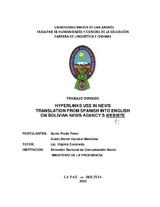Mostrar el registro sencillo del ítem
HYPERLINKS USE IN NEWS TRANSLATION FROM SPANISH INTO ENGLISH ON BOLIVIAN NEWS AGENCY’S WEBSITE
| dc.contributor.author | Prado Pérez, Sonia | |
| dc.contributor.author | Escobar Mendieta, Guido Martín | |
| dc.contributor.author | Coronado, Virginia (tutor) | |
| dc.date.accessioned | 2018-05-16T19:45:21Z | |
| dc.date.available | 2018-05-16T19:45:21Z | |
| dc.date.issued | 2010 | |
| dc.identifier.citation | Lenguas Extranjeras. Inglés. | es_ES |
| dc.identifier.uri | http://repositorio.umsa.bo/xmlui/handle/123456789/15981 | |
| dc.description.abstract | Mass media is a term used to refer to the media whose reach is at national, international or worldwide level. Such term appeared in 1920 (approximately); but mass information spreading occurred many centuries before. For Example Johannes Gutenberg printed a 42 line Bible in 1453 with a movable type printing press. This invention is considered of great importance regarding information spreading over middle Ages. In 1612, the first newspapers appeared; however, they reached a large-scale circulation from 19th century. Hertz wave application by Guglielmo Marconi in 1901 and TV experimental broadcast by John Logie Baird in 1926 opened a new technology to transmit information at worldwide level. However, the technological progresses to transmit information did not stop with radio and television. The first international connection of computers in a network was made in 1973; later this system was called Internet. All this technology from printing to Internet was channeled into making the information access easier and faster. Internet as a latest technological tool to spread information joins, somehow, all the previous systems because it is possible to find websites, which include newspapers, radio and TV on them. Another advantage of Internet is that any information can be downloaded from any country. It is known that English is the “lingua franca” (Webster’s New World Dictionary, 2004:835) in the world of technology; therefore, the different countries around the world give more importance to broadcast websites in English than in any other languages since it allows them to expand their services at worldwide level and catch more users for their websites. In that sense, the Bolivian News Agency understood that the best way to take advantage of the internet is to broadcast its news in English; in other words to translate news from Spanish into English and broadcast them in a section at the abi.bo. The present supervised work is a sample about how a website can be improved using the informatics computer technology. The following chapters describe and explain gradually all the process to introduce the hyperlinks section at the Bolivian News Agency website (abi.bo) and how this useful tool provides users extra information about certain topics, words and phrases, which are close related to the Bolivian cultural context. | es_ES |
| dc.language.iso | en | es_ES |
| dc.publisher | Universidad Mayor de San Andrés. Facultad de Humanidades y Ciencias de la Educación. Carrera de Lingüística e Idiomas. | es_ES |
| dc.subject | HYPERLINKS - NEWS AGENCY’S WEBSITE | es_ES |
| dc.title | HYPERLINKS USE IN NEWS TRANSLATION FROM SPANISH INTO ENGLISH ON BOLIVIAN NEWS AGENCY’S WEBSITE | es_ES |
| dc.type | Thesis | es_ES |

